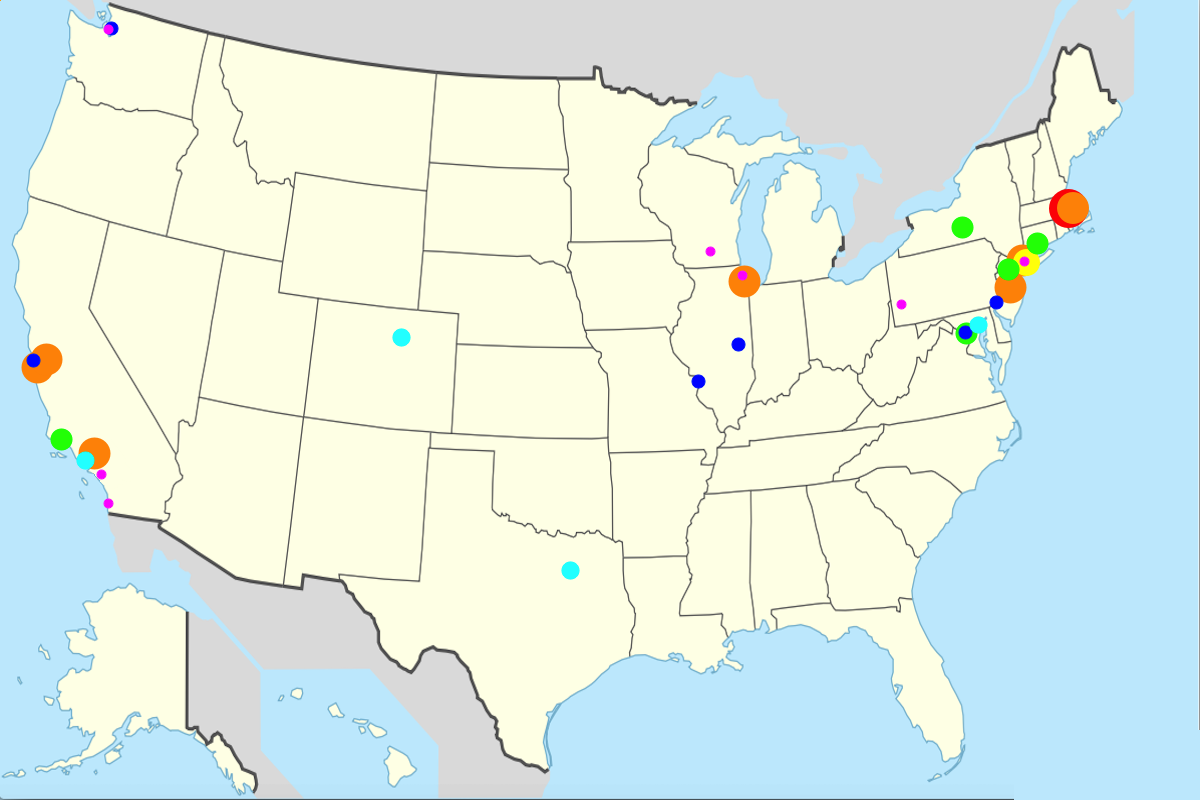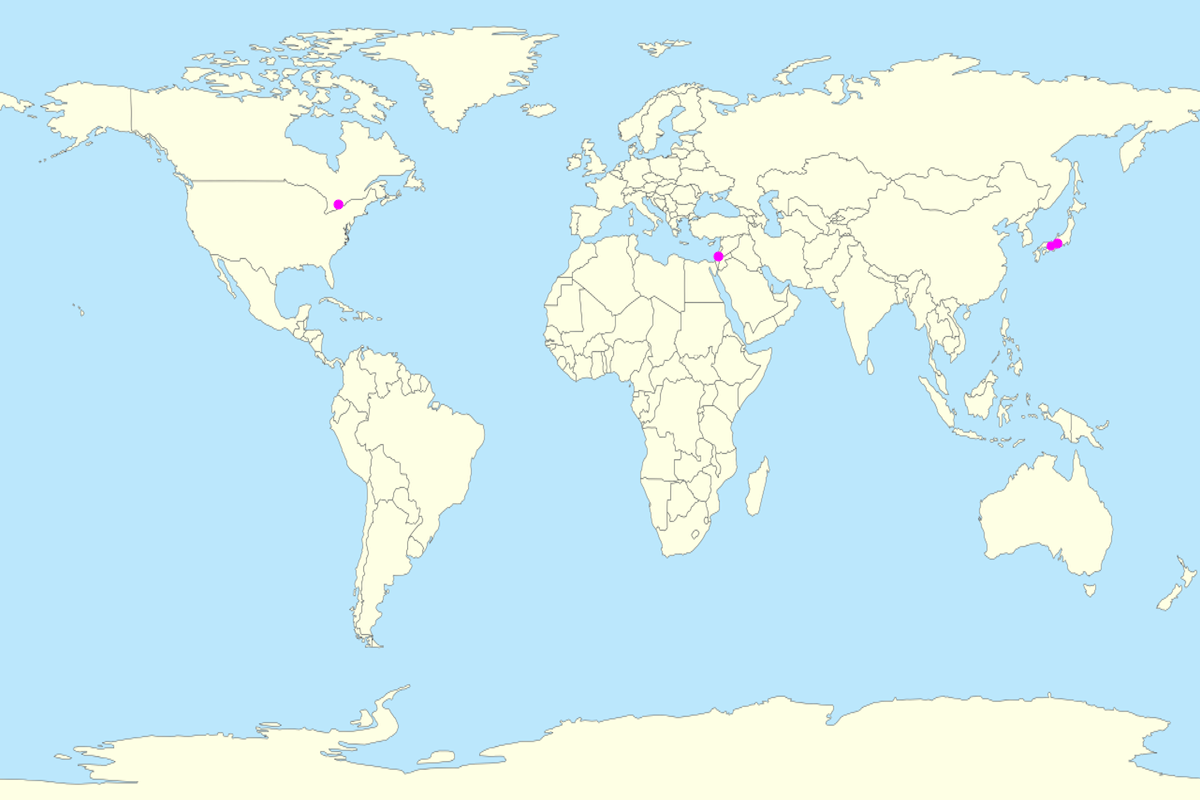




Answer to Map #19
This week’s map is split into four pieces. Here are links to larger versions of the pieces showing the United States, the United Kingdom, Europe, and the world.
Back to this week’s map and hints.
Answer: On this proportional symbol map, dots represent institutions that have produced winners of the Nobel Prize. The size of the dots represents the number of Nobel laureates affiliated with those institutions.
The smallest magenta dots indicate institutions that have produced three winners of the Nobel Prize. Many institutions have produced one or two winners, but they are not represented on this map. The largest red dot indicates Harvard University in Cambridge, Massachusetts, which has had 35 winners. The next largest dot, colored orange, corresponds to institutions that have produced between 16 and 22 winners: Stanford University (22), the Massachusetts Institute of Technology (18), the University of Cambridge (18), the University of California, Berkeley (18), the University of Chicago (18), the California Institute of Technology (17), Columbia University (17), and Princeton University (16).
Most, but not all, of the institutions marked on this map are major research universities. The map also includes some research institutes that do not enroll students or grant degrees, such as the National Institutes of Health (4) in Bethesda, Maryland; the Howard Hughes Medical Institute (6) in Chevy Chase, Maryland; and the Fred Hutchison Cancer Research Center (3) in Seattle, Washington. Several of the dots on this map correspond to for-profit companies that have conducted important technological research, including the Zurich lab of IBM (4) and Bell Labs (7) (now owned by Nokia) in Murray Hill, New Jersey. Often, important independent research labs spring up in the vicinity of major universities in cities that are home to many scientists. This phenomenon helps explain why the city of Cambridge in the United Kingdom is represented by two dots: one orange one for the University of Cambridge and another green one for the Medical Research Council Laboratory of Molecular Biology (8), which employed, among others, Frederick Sanger and Francis Crick.
It can be difficult to get an accurate accounting of the research affiliations of various Nobel laureates. Most people win Nobel Prizes after long and distinguished careers in which they have benefited from ties to many different institutions. After a person wins, all those institutions try to claim that person as their own. Harvard, for example, claims on its website that it has ties to 49 Nobel laureates. Wikipedia maintains a list that says Harvard is affiliated with no fewer than 134 laureates, including 76 students who attended Harvard but were not affiliated with the university when they won.
For our map, we relied on data directly from the website of the Nobel Prize, which maintains an official list of the research affiliations of each laureate that ascribes only one institution to each winner. This list tracks only winners in disciplines that are traditionally researched at institutions: Physics, Chemistry, Physiology and Medicine, and Economic Sciences. There have been laureates in other disciplines who were full-time employees of universities (Wole Soyinka, for example, was a professor of comparative literature at the University of Ife in Nigeria when he won the Nobel Prize in literature in 1986), but these winners are not included on the official list.
Even with an official list, it is difficult to put together the data enough to make a proportional symbol map. In some cases, the list includes constituent parts of larger institutions separately, and we have tried to combine them together. Moreover, many universities have changed their names, merged, split up, or even moved over the years. The University of Strasbourg, which has not changed its name, is even listed separately because it has produced winners while part of two different countries: Germany in 1909 and France in 2011, 2013, and 2016.
We apologize for a few oversights on the original map that went up last Monday. We were missing dots for the University of Edinburgh, Kyoto University, and Carnegie-Mellon University, which are all listed on this list under separate headings. Note that we have combined Carnegie-Mellon University’s winners with the winner from the Carnegie Institute of Technology, which was the predecessor to the current institution. Similarly, we have combined the winners from the University of Manchester with those from Victoria University of Manchester, which was a predecessor of that institution.
An interesting case is a particular German research institution. Fritz Haber won the Nobel Prize in chemistry in 1918 as a researcher for the Kaiser Wilhelm Institute in Berlin. Subsequently, Haber’s laboratory became its own institute, the Fritz Haber Institute, under the auspices of the larger Kaiser Wilhelm Institute. After World War II, the Kaiser Wilhelm Institute was renamed the Max Planck Institute, which has branches all over Germany. The Max Planck Institute, the Fritz Haber Institute, and the Kaiser Wilhelm Institute have all produced Nobel laureates. (Max Planck himself, however, won his while working for Berlin University, rather than for the entity that would eventually bear his name) To resolve this situation, we have tried to combine all the winners of these institutes in Berlin into a single green dot; there is also a magenta dot for the branch of the Max Planck Institute in Göttingen, which has produced three winners. It’s very confusing! We apologize for any errors in judgment resulting in errant dot placement!
One conclusion that seems obvious from this map is that research in the sciences has historically been dominated by institutions in Western Europe and the United States. Our “world” map has only four dots, representing Nagoya University in Nagoya, Japan; Kyoto University in Kyoto, Japan; Technion in Haifa, Israel; and the University of Toronto in Toronto, Canada. It seems likely that East Asian and South Asian universities, many of which are conducting cutting edge research in the sciences, will soon begin to appear on this map.
Next map: Click here to try out our newest map question.
